
A wig is a head covering made from human or animal hair, or a synthetic imitation thereof. The word is short for "periwig". Wigs may be worn to disguise baldness, to alter the wearer's appearance, or as part of certain professional uniforms.
History
Ancient and medieval use
In Egyptian society men and women commonly had clean-shaven or close-cropped hair and often wore wigs. The ancient Egyptians created the wig to shield shaved, hairless heads from the sun. They also wore the wigs on top of their hair using beeswax and resin to keep the wigs in place. Wealthy Egyptians would wear elaborate wigs and scented head cones of animal fat on top of their wigs. Other ancient cultures, including the Assyrians, Phoenicians, Jews in ancient Israel and Judea, Greeks, and Romans, also used wigs as an everyday fashion.
Examples of ancient wigs-
 Statue of princess Nofret wearing a wig (c. 2613 to 2494 BC)
Statue of princess Nofret wearing a wig (c. 2613 to 2494 BC)
-
 Egyptian couple wearing formal wigs of the 4th or 5th dynasties
Egyptian couple wearing formal wigs of the 4th or 5th dynasties
-
 Tomb fresco depicting dancers and musicians in elaborate wigs with head cones. Thebes, Egypt, 18th Dynasty.
Tomb fresco depicting dancers and musicians in elaborate wigs with head cones. Thebes, Egypt, 18th Dynasty.
-
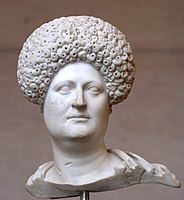 Bust of a Roman woman wearing a "diadem" wig, c. 80 CE
Bust of a Roman woman wearing a "diadem" wig, c. 80 CE
-
 Wig Headdress, Wari People, 600–1000 CE, Brooklyn Museum
Wig Headdress, Wari People, 600–1000 CE, Brooklyn Museum
In China, the popularization of the wig started in the Spring and Autumn period.
In Japan, the upper classes started wearing wigs before the Nara period.
In Korea, gache were popular among women during the Goryeo dynasty until they were banned in the late 18th century.
16th and 17th centuries
After the fall of the Western Roman Empire, the use of wigs fell into disuse in the West for a thousand years until they were revived in the 16th century as a means of compensating for hair loss or improving one's personal appearance. They also served a practical purpose: the unhygienic conditions of the time meant that hair attracted head lice, a problem that could be much reduced if natural hair were shaved and replaced with a more easily de-loused artificial hairpiece. Fur hoods were also used in a similar preventive fashion.
Royal patronage was crucial to the revival of the wig. Queen Elizabeth I of England famously wore a red wig, tightly and elaborately curled in a "Roman" style, while among men King Louis XIII of France (1601–1643) started to pioneer wig-wearing in 1624 when he had prematurely begun to bald. This fashion was largely promoted by his son and successor Louis XIV of France (1638–1715), which contributed to its spread in Europe and European-influenced countries in the 1660s. Wig-wearing remained a dominant style among men for about 140 years until the change of dress, affected by the French Revolution, in the 1790s.
Perukes or periwigs for men were introduced into the English-speaking world with other French styles when Charles II was restored to the throne in 1660, following a lengthy exile in France. These wigs were shoulder-length or longer, imitating the long hair that had become fashionable among men since the 1620s. Their use soon became popular in the English court. The London diarist Samuel Pepys recorded the day in 1665 that a barber had shaved his head and that he tried on his new periwig for the first time, but in a year of plague he was uneasy about wearing it:
3rd September 1665: Up, and put on my coloured silk suit, very fine, and my new periwig, bought a good while since, but darst not wear it because the plague was in Westminster when I bought it. And it is a wonder what will be the fashion after the plague is done as to periwigs, for nobody will dare to buy any haire for fear of the infection? That it had been cut off the heads of people dead of the plague.
Wigs were not without other drawbacks, as Pepys noted on March 27, 1663:
I did go to the Swan; and there sent for Jervas my old periwig-maker and he did bring me a periwig; but it was full of nits, so as I was troubled to see it (it being his old fault) and did send him to make it clean.
With wigs virtually obligatory garb for men with social rank, wigmakers gained considerable prestige. A wigmakers' guild was established in France in 1665, a development soon copied elsewhere in Europe. Their job was a skilled one as 17th century wigs were extraordinarily elaborate, covering the back and shoulders and flowing down the chest; not surprisingly, they were also extremely heavy and often uncomfortable to wear. Such wigs were expensive to produce. The best examples were made from natural human hair. The hair of horses and goats was often used as a cheaper alternative.
Several contemporary writings which have survived noted that some viewed men who wore wigs as looking deformed and emasculated. It especially attracted disapproval from Puritans, and during times of plague, it was said that wigs were made of hair of plague victims.
Wigs required cleaning using fuller's earth, and the powder used to freshen it was made from low grade flour and scented with pomatum.
Examples of wigs in the 16th and 17th centuries-
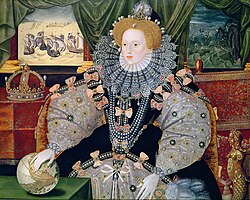 Queen Elizabeth I, painted in 1588
Queen Elizabeth I, painted in 1588
-
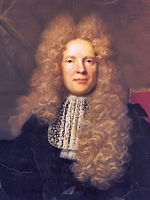 Nicolas de Vermont
Nicolas de Vermont
-
 Portrait of men wearing wigs by Nicolas de Largillière, 17th century
Portrait of men wearing wigs by Nicolas de Largillière, 17th century
-
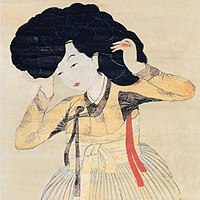 Korean traditional wig (gache)
Korean traditional wig (gache)
-
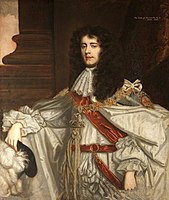 James Scott, 1st Duke of Monmouth, (illegitimate son of Charles II of England)
James Scott, 1st Duke of Monmouth, (illegitimate son of Charles II of England)
18th century



In the 18th century, men's wigs were powdered to give them their distinctive white or off-white color. Women in the 18th century did not wear wigs, but wore a coiffure supplemented by artificial hair or hair from other sources. Powdered wigs (men) and powdered natural hair with supplemental hairpieces (women) became essential for full dress occasions and continued in use until almost the end of the 18th century.
The elaborate form of wigs worn at the coronation of George III in 1761 was lampooned by William Hogarth in his engraving Five Orders of Periwigs. Powdering wigs and extensions was messy and inconvenient, and the development of the naturally white or off-white powderless wig (made of horsehair) for men made the retention of wigs in everyday court dress a practical possibility. By 1765, wig-wearing went out of fashion except for some occupational groups such as coachmen and lawyers. During this period, people tended to simply wear their natural hair, styled and powdered to resemble a wig. However, the trend revived extravagantly during the Macaroni period of the 1770s. Women mainly powdered their hair grey, or blue-ish grey, and from the 1770s onwards never bright white like men. Wig powder was made from finely ground starch that was scented with orange flower, lavender, or orris root. Wig powder was occasionally colored violet, blue, pink or yellow, but was most often off-white.
By the 1780s, young men were setting a fashion trend by lightly powdering their natural hair, as women had already done from the 1770s onwards. After 1790, both wigs and powder were reserved for older, more conservative men, and were in use by ladies being presented at court. After 1790, English women seldom powdered their hair.
In 1795, the British government levied a tax on hair powder of one guinea per year. This tax effectively caused the demise of both the fashion for wigs and powder. Granville Leveson-Gower, in Paris during the winter of 1796, at the height of the Thermidorian Directory, noted "The word citoyen seemed but very little in use, and hair powder being very common, the appearance of the people was less democratic than in England."
Among women in the French court of Versailles in the mid-to-late 18th century, large, elaborate and often themed wigs (such as the stereotypical "boat poufs") were in vogue. These combed-up hair extensions were often very heavy, weighted down with pomades, powders, and other ornamentation. In the late 18th century these coiffures (along with many other indulgences in court life) became symbolic of the decadence of the French nobility, and for that reason quickly became out of fashion from the beginning of the French Revolution in 1789.
During the 18th century, men's wigs became smaller and more formal with several professions adopting them as part of their official costumes. This tradition survives in a few legal systems. They are routinely worn in various countries of the Commonwealth. Until 1823, bishops of the Church of England and Church of Ireland wore ceremonial wigs. The wigs worn by barristers are in the style favoured in the late eighteenth century. Judges' wigs, in everyday use as court dress, are short like barristers' wigs (although in a slightly different style), but for ceremonial occasions judges and also senior barristers (KCs) wear full-bottomed wigs.
In the 18th century, wigmaking was a craft guild in multiple cities. The guilds, government, and others were constantly concerned about quality. The Lyon Wigmaker Guild petitioned local magistrates to uphold statutes banning bleached human hair, as well as wild goat and lamb hair. The guild officers claimed that the process of bleaching damaged the hair too much, thereby forcing a wigmaker to sell a faulty product to consumers. As for the wild goat and lamb hair, they claimed it was too coarse to style. 18th century French wigmakers used an interesting technique to ensure that the hair retained moisture: baking hair into dough. In Paris, gingerbread bakers would routinely bake hair dough for wigmakers, although in other French cities, it was not necessarily gingerbread. Taxes on hair dough baking were proposed in 1705. In Grenoble, wigmakers complained that such tax obligations "destroy the liberty of commerce; because no baker is obliged to bake wigmakers' hair dough, instead doing it for them as a courtesy."
Examples of 18th century wigs-
 Marie Antoinette wearing the distinctive pouf style coiffure; her own natural hair is extended on the top with an artificial hairpiece.
Marie Antoinette wearing the distinctive pouf style coiffure; her own natural hair is extended on the top with an artificial hairpiece.
-
 Charles-Alexandre de Calonne by Élisabeth-Louise Vigée-Le Brun (1784), London, Royal Collection
Charles-Alexandre de Calonne by Élisabeth-Louise Vigée-Le Brun (1784), London, Royal Collection
-
 Colonel James Hamilton by John Smart (1784), wearing a white wig powdered with pink-coloured powder.
Colonel James Hamilton by John Smart (1784), wearing a white wig powdered with pink-coloured powder.
-
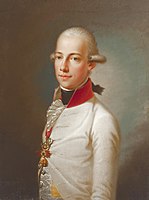 Archduke John of Austria (1782–1859) as a boy (c. 1795), the latest-born notable person to be portrayed wearing a powdered wig tied in a queue.
Archduke John of Austria (1782–1859) as a boy (c. 1795), the latest-born notable person to be portrayed wearing a powdered wig tied in a queue.
19th and 20th centuries
Due to the association with ruling classes in European monarchies, the wearing of wigs as a symbol of social status was largely abandoned in the newly created republics, the United States and France, by the start of the 19th century, though formal court dress of European monarchies still required a powdered wig or long powdered hair tied in a queue until the accession of Napoleon Bonaparte (1769–1821) to the throne as emperor in 1804.
In the United States, only four presidents, from John Adams (1735–1826) to James Monroe (1758–1831), wore curly powdered wigs tied in a queue according to the old-fashioned style of the 18th century, though Thomas Jefferson (1743–1826) wore a powdered wig only rarely and stopped wearing a wig entirely shortly after becoming president in 1801. John Quincy Adams (1767–1848) also wore a powdered wig in his youth, but he abandoned this fashion while serving as the U.S. Minister to Russia (1809–1814), long before his accession to the presidency in 1825. Unlike them, the first president, George Washington (1732–1799), never wore a wig; instead, he powdered, curled and tied in a queue his own long hair.
Women's wigs developed in a somewhat different way. They were worn from the 18th century onwards, although at first only surreptitiously. Full wigs in the 19th and early 20th century were not fashionable. They were often worn by old ladies who had lost their hair. In the film Mr. Skeffington (1944), Bette Davis's character has to wear a wig after a bout of diphtheria, which is a moment of pathos and a symbol of her frailty.
During the late nineteenth and early twentieth century hairdressers in England and France did a brisk business supplying postiches, or pre-made small wiglets, curls, and false buns to be incorporated into the hairstyle. The use of postiches did not diminish even as women's hair grew shorter in the decade between 1910 and 1920, but they seem to have gone out of fashion during the 1920s. In the 1960s a new type of synthetic wig was developed using a modacrylic fiber which made wigs more affordable. Reid-Meredith was a pioneer in the sales of these types of wigs.
Presidents of the United States in powdered wigs-
 John Adams in 1788
John Adams in 1788
-
 Thomas Jefferson in 1786
Thomas Jefferson in 1786
-
 James Madison in c. 1770–1780
James Madison in c. 1770–1780
-
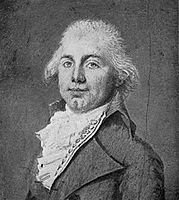 James Monroe in 1794
James Monroe in 1794
-
 Charles X (1757–1836), the future King of France, as Count of Artois in 1771, wears a curly powdered wig tied in a queue.
Charles X (1757–1836), the future King of France, as Count of Artois in 1771, wears a curly powdered wig tied in a queue.
-
 Charles X, depicted as King of France (1824–1830), wears a short unpowdered haircut.
Charles X, depicted as King of France (1824–1830), wears a short unpowdered haircut.
21st century
The art of wigs became a billion dollar industry in the 21st century. Three main processes happen within the industry: the collection of material, manufacturing, and distribution. India is the main source of hair. It has been reported from time to time that for global human hair trade, women from the ASEAN region are being exploited. Hair from this region has a significant commercial value in the international market. Particularly in India, the women are forced by their husbands into selling their hair, and slum children were being tricked into "having their heads shaved in exchange for toys". Scrap pickers are another source of hair in India, these people find hair in miscellaneous places such as hair brushes, clothes, or in the trash. While manufacturing and processing mainly takes place in China, where the hair is sorted through and constructed into wigs, the final product exported abroad, with the top countries being the United States and the United Kingdom.
Official use
In the United Kingdom, most Commonwealth nations and Ireland, special wigs are also worn by barristers, judges and certain parliamentary and municipal or civic officials as a symbol of the office.
Hong Kong barristers and judges continue to wear wigs as part of court dress as a legacy of the court system from the time of British rule.
In July 2007, judges in New South Wales, Australia, voted to discontinue the wearing of wigs in the NSW Court of Appeal.
New Zealand lawyers and judges have ceased to wear wigs except for ceremonial occasions, such as when newly qualified lawyers are called to the bar.
In Canada lawyers and judges do not wear wigs.
Entertainment
A number of celebrities, including Donna Summer, Dolly Parton, Sia, Nicki Minaj, Katy Perry, Lady Gaga, Diana Ross & The Supremes, Tina Turner and Raquel Welch, popularized wigs. Cher has worn all kinds of wigs in the last 40 years, from blonde to black, and curly to straight. They may also be worn for fun as part of fancy dress (costume wearing), when they can be of outlandish color or made from tinsel. They are quite common at Halloween, when "rubber wigs" (solid bald cap-like hats, shaped like hair), are sold at some stores.
Wigs are used in film, theater, and television. In the Japanese film and television genre Jidaigeki, wigs are used extensively to alter appearance to reflect the Edo period when most stories take place. Only a few actors starring in big-budgeted films and television series will grow their hair so that it may be cut to the appropriate hair style, and forgo using a wig.
In the theater, especially on Broadway, wigs are used to give a performer a fixed character. Nearly all women and many men do so not only for character design, but also to cover their microphone packs. Often the microphone pack goes on the actor's head, mainly to efficiently facilitate quick changes.
An actor not wearing a wig needs to change their look every time they go on stage. The wig helps solidify the character's design; natural hair is different day to day.
Convenience
Wigs are worn by some people on a daily or occasional basis in everyday life. This is sometimes done for reasons of convenience, since wigs can be styled ahead of time. A common practice of wigs for convenience is called protective styling. Many use wigs to avoid damage to their natural tresses, or to create styles that may not be possible otherwise. They are also worn by individuals who are experiencing hair loss for medical reasons (most commonly cancer patients who are undergoing chemotherapy, or those who are suffering from alopecia areata).
Some men who crossdress as women wear wigs in different styles to make their hair seem more feminine.
Merkin
Main article: MerkinA merkin is a pubic wig often worn as a decorative item or for theatrical and fashion purposes. They are sometimes viewed as erotic and some designs are meant for entertainment or as a form of comedy.
Image gallery
Examples of contemporary wigs-
 Colourful wigs for costume parties
Colourful wigs for costume parties
-
 An assortment of wigs in display cabinet
An assortment of wigs in display cabinet
-
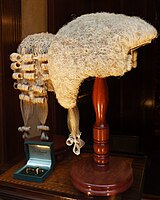 Wigs as court dress
Wigs as court dress
-
 Japanese wig for traditional hairstyle
Japanese wig for traditional hairstyle
Military wigs
From the late 17th to early 19th centuries, European armies wore uniforms more or less imitating the civilian fashions of the time, but with militarized additions. As part of that uniform, officers wore wigs more suited to the drawing rooms of Europe than its battlefields. The late 17th century saw officers wearing full-bottomed natural-coloured wigs, but the civilian change to shorter, powdered styles with pigtails in the early 18th century saw officers adopting similar styles. The elaborate, oversized court-styles of the late 18th century were not followed by armies in the field however, as they were impractical to withstand the rigours of military life and simpler wigs were worn.
While officers normally wore their own hair short under a powdered wig, the rank and file of the infantry was not afforded such luxury. Instead of wigs, the men grew their hair long and according to the prevailing fashion in a nation's army, hair was either allowed to grow long with simple modeling, as in the French army of the 1740s, or else was elaborately coiffured as in Prussian and British armies. In the case of British soldiers of the 1740s, contemporary artwork suggests that they cut their hair short, which was not the case. Instead, the men used tallow or other fat to grease the hair, which was then fashioned into pigtails and tied back into the scalp hair to give the impression of short hair. It was then liberally dusted with powdered chalk to give the impression of a powdered wig. Later in the century, hair was likewise tied back, greased and powdered, but false hair pigtails were adopted, kept in a tubular queue and tied back with ribbons to the soldier's own hair. The overall effect was that of a wig with a long tail and bow. The Prussian army took personal hairstyles to an extreme during the time of Frederick the Great, each soldier commonly having a long pigtail hanging down the back nearly to waist level.
By contrast, Grigory Potemkin, a Russian statesman and favourite of Catherine the Great, abhorred the tight uniforms and uncomfortable powdered wigs tied in a queue worn by soldiers of the Russian Army and instigated a complete revision of both in the 1780s. Along with comfortable, practical, well-fitting uniforms, his reforms introduced short, natural hairstyles for all, with no wigs, powder and grease, or long hair tied in a queue.
Formal military hairstyles lasted until beyond the end of the 18th century and it was the French Revolution which spelled the end of wigs and powdered, greased hairstyles in modern, Western armies. Powdered hair and pigtails made a brief return during Napoleon's reign, being worn by infantry of his Foot Grenadiers and Foot Chasseurs of the Old Guard and the Horse Grenadiers of the Guard.
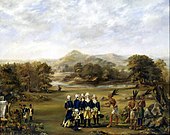
United States Army soldiers wore powdered wigs tied in a queue as a standard part of the military uniform until 1801. In 1801 James Wilkinson, a Senior Officer of the U.S. Army, issued an order to remove all queues, which had been worn in the army since the Revolutionary War (1775–1783). This order applied also to powdered wigs tied in queue and was highly unpopular with both officers and men, leading to several desertions and threats of resignation.
Religious
Judaism
Jewish law requires married women to cover their hair for reasons of tzniut (Hebrew: "modesty or privacy"). Some Orthodox Jewish women wear wigs, known as sheitels, for this purpose. Wigs of those who practice Haredi Judaism and Hasidic Judaism often are made from human hair. In Modern Orthodox Judaism, women will usually wear a scarf, kerchief, snood, hat or other covering, sometimes exposing the bottom of their hair.
One rabbi has declared that long wigs are inappropriate. Another said that it is preferable for a married Jewish woman to expose her hair than to don a wig, for the wig actually increases attraction in the public domain and encourages the notion that Halakha is both irrational and intellectually dishonest. Still another rabbi, who also spoke strongly against the wearing of wigs, said specifically, "You must go with a hat or kerchief on your head", but did not permit leaving hair "exposed".
Most Orthodox women cover their hair, whether with wigs, hats or scarves. The rejection by some rabbis of wigs is not recent, but began "in the 1600s, when French women began wearing wigs to cover their hair. Rabbis rejected this practice, both because it resembled the contemporary non-Jewish style and because it was immodest, in their eyes, for a woman to sport a beautiful head of hair, even if it was a wig."
Other options include:
- wearing a covered wig, called a shpitzel
- a covering, typically cloth, called a tichel
- another non-hair (and looser) head covering, called a snood
- a short wig mostly covered by a tichel, but with (wig) "hair" showing on the forehead, sometimes also showing from the back, called a frisette [fr]
Manufacture
In the 18th and 19th centuries, wigmakers were called perruquiers.
There are two methods of attaching hair to wigs. The first and oldest is to weave the root ends of the hair onto a stretch of three silk threads to form a sort of fringe called a "weft". The wefts are then sewn to a foundation made of net or other material. In modern times, the wefts can also be made (a warp is the vertical thread of a weave, the weft is the horizontal thread) with a specially adapted sewing machine, reducing the amount of hand labour involved. In the 19th century another method came into use. A small hook called a "ventilating needle" or "knotting needle", similar to the tambour hooks used for decorating fabric with chain-stitch embroidery at that period, is used to knot a few strands of hair at a time directly to a suitable foundation material. This newer method produces a lighter and more natural looking wig. High quality custom wigs, and those used for film and theatrical productions are usually done this way. It is also possible to combine the two techniques, using weft for the main part of the wig and ventilating hair at the edges and partings to give a fine finish.

Measurement
Making custom wigs starts with measuring the subject's head. The natural hair is arranged in flat curls against the head as the various measurements are taken. It is often helpful to make a pattern from layers of transparent adhesive tape applied over a piece of plastic wrap, on which the natural hairline can be traced accurately. These measurements are then transferred to the "block", a wooden or cork-stuffed canvas form the same size and shape as the client's head.
Foundation
Depending on the style of the wig, a foundation is made of net or other material, different sizes and textures of mesh being used for different parts of the wig. The edges and other places might be trimmed and reinforced with a narrow ribbon called "galloon". Sometimes flesh colored silk or synthetic material is applied where it will show through the hair at crown and partings, and small bones or elastic are inserted to make the wig fit securely. Theatrical, and some fine custom wigs, have a fine, flesh colored net called "hair lace" at the front which is very inconspicuous in wear and allows the hair to look as if it is coming directly from the skin underneath. These are usually referred to as "lace front wigs".
Hair preparation
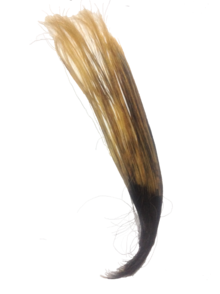
Natural hair, either human or from an animal such as a goat or yak, must be carefully sorted so that the direction of growth is maintained, root to root, and point to point. Because of the scale-like structure of the cuticle of a hair shaft, if some hairs get turned the wrong way, they will ride backwards against their neighbors and cause tangles and matting. The highest quality of hair has never been bleached or colored, and has been carefully sorted to ensure the direction is correct. This process is called "turning". For less expensive wigs, this labour-intensive sorting process is substituted by "processing" the hair. It is treated with a strong base solution which partially dissolves the cuticle leaving the strands smooth. It is then bleached and dyed to the required shade and given a synthetic resin finish which partially restores the strength and luster of the now damaged hair. Synthetic fiber, of course, is simply manufactured in the required colors, and has no direction.
The wigmaker will choose the type, length and colors of hair required by the design of the wig and blend them by pulling the hair through the upright teeth of a brush-like tool called a "hackle" which also removes tangles and any short or broken strands. The hair is placed on one of a pair of short-bristled brushes called "drawing brushes" with the root ends extending over one edge; the edge facing the wigmaker (or properly called, boardworker), and the second brush is pressed down on top of it so that a few strands can be withdrawn at a time, leaving the rest undisturbed.
Adding the hair
Weft structured wigs can have the wefts sewn to the foundation by hand, while it is on the block or, as is common with mass-produced wigs, sewn to a ready-made base by skilled sewing machine operators. Ventilated (hand knotted) wigs have the hair knotted directly to the foundation, a few strands at a time while the foundation is fastened to the block. With the hair folded over the finger, the wigmaker pulls a loop of hair under the mesh, and then moves the hook forward to catch both sides of the loop. The ends are pulled through the loop and the knot is tightened for a "single knot", or a second loop is pulled through the first before finishing for a "double knot". Typically, the bulkier but more secure double knot is used over the majority of the wig and the less obvious single knot at the edges and parting areas. A skilled wigmaker will consider the number of strands of hair used and the direction of each knot to give the most natural effect possible.
It takes generally six heads of hair to make a full human hair wig.
Styling
At this point, the hair on the wig is all the same length. The wig must be styled into the desired form in much the same manner as a regular stylist.
Fitting
The subject's natural hair is again knotted tightly against the head and the wig is applied. Any remaining superfluous wiglace is trimmed away. Hairpins can be used to secure the lace to the hair and occasionally, skin-safe adhesives are used to adhere the wig against bald skin and to better hide any exposed lace. Finishing touches are done to the hair styling to achieve the desired effect.
Types of human hair wigs
There are two basic kinds of hair wigs: The traditional machine stitched weft wig and the hand tied lace wig. The machine stitched wigs are still the most widely worn wigs today. The hair is sewn on a stretch weft material and come with back straps for adjusting to various head sizes. These wigs are typically pre-styled and lack any kind of realistic expectations.
Lace wigs are quickly becoming one of the most sought-after wigs among wig wearers. The illusion of hair growing from the scalp is the feature that makes this wig the best of the best when it comes to wearing fake hair. These wigs are made with a French or Swiss lace material base. They are made as a full lace or partial lace front with a stretch weft back. Each hair strand is individually stitched into a lace material which creates the natural look of hair at the base. This is where the term "hand tied" originates.
Hair type is the distinguishing factor in human hair wigs. Four main types of hair are used in manufacturing: Chinese or "Malaysian", Indian, Indonesian or "Brazilian", and Caucasian or "European". The majority of human hair wigs are made of Chinese or Indian hair, while European hair is considered the most expensive and rare, as most donors are from Russia or Northern Europe, where there is a smaller portion of hair donors to the market.
Remy human hair is considered to be the best quality of human hair because the cuticles are kept intact and not stripped away; "strands retain their scaled natural outer cuticle." The preserved cuticles are also aligned in a unidirectional manner, which decreases tangling and matting. Also, the hair is carefully separated after collecting from the donor to ensure all the cuticles are of the same length.
Notable wig designers
- Willy Clarkson, who created wigs for London's West End theatre productions
- Nina Lawson, who ran the Metropolitan Opera wig department from 1956 to 1987
- Peter King, Bristol, United Kingdom
- Peter Owen, Bristol, United Kingdom
See also
References
- "The Worldwide Hair Wigs and Extensions Industry is Expected to Reach $12.2 Billion by 2027 - ResearchAndMarkets.com". Retrieved October 25, 2022.
- "wig". Oxford English Dictionary (Online ed.). Oxford University Press. doi:10.1093/OED/1028260406. (Subscription or participating institution membership required.)
- ^ Wallenfels, Ronald (2000). The Ancient Near East: An Encyclopedia for Students, Volume 2. Scribner. p. 145. ISBN 9780684805948.
- Fletcher, Joann; Salamone, Filippo (2016). "An Ancient Egyptian Wig: Construction and Reconstruction". Internet Archaeology (42). doi:10.11141/ia.42.6.3.
- "Dumuzid and Jectin-ana". The Electronic Text Corpus of Sumerian Literature. December 19, 2006. Retrieved March 16, 2013.
- Mishna tractate Sabbath Chapter 6 Mishna 5
- Snodgrass, Mary Ellen (2015). World Clothing and Fashion: An Encyclopedia of History, Culture, and Social Influence. Routledge. pp. 119–121. ISBN 9781317451679.
- "Fashion: The history of the wig: On a wig and a prayer". The Independent. January 17, 1999.
- "Perukes, Pomade, and Powder: Hair Care in the 1700s". January 28, 2015.
- "A Brief History of the Wig". June 15, 2015.
- Marcel Gomes. "Louis XIII". The Beautiful Times. Retrieved March 16, 2013.
- Samuel Pepys; Henry Benjamin Wheatley (1895). The Diary of Samuel Pepys (Volume 9, Page 60).
- Chaudhary, Amit (July 10, 2018). "History of Hair Wigs - Why It is in Trend Today - Artificial Heads of Hair". Planetofhaircloning.com.
- ^ Cockayne, Emily (2021). Filth, Noise & Stench in England. Yale University Press. pp. 66–72.
- McDowall, Carolyn. "Adventures in Hair for 18th Century Gentlemen". The Culture Concept Circle. Retrieved July 19, 2020.
- "When Did Men Stop Wearing Wigs?". June 8, 2017.
- "Hair Powder Tax". All Things Georgian. July 22, 2013.
- Noted in Janet Gleeson, Privilege and Scandal: The Remarkable Life of Harriet Spencer, Sister of Georgiana 2006:178.
- "History of Court Dress". Courts and Tribunals Judiciary. Retrieved February 6, 2023.
- Gayne, Mary K. “Illicit Wigmaking in Eighteenth-Century Paris.” Eighteenth-Century Studies, vol. 38, no. 1, 2004, pp. 119–37. JSTOR, http://www.jstor.org/stable/30053631. Accessed 3 Dec. 2023.
- Albert J. Menendez (1983). Christmas in the White House. Westminster John Knox Press. p. 56. ISBN 0-664-21392-8.
- Whitcomb, John; Whitcomb, Claire (May 3, 2002). Real life at the White House: 200 years of daily life at America's most famous residence (1st Routledge pbk. ed.). London: Routledge. ISBN 978-0-415-93951-5. Retrieved April 20, 2010.
- Merril D. Smith (2015). The World of the American Revolution: A Daily Life Encyclopedia [2 volumes]: A Daily Life Encyclopedia. ABC-CLIO. p. 261. ISBN 978-1-4408-3027-3.
- Hewson, Martha S. (January 1, 2009). John Quincy Adams. Infobase. ISBN 978-0-7910-7599-9. Retrieved November 4, 2018.
- "Frequently Asked Questions: Did George Washington wear a wig?". The Papers of George Washington. University of Virginia. Archived from the original on November 20, 2005. Retrieved October 4, 2010.
- Emile Long, Hairstyles and Fashion: A Hairdresser's History of Paris, 1910–1920, edited with an introduction by Steven Zdatny, Berg (Oxford International Publishers Ltd), 1999 ISBN 1-85973-222-4
- "Expert Says Korean Labor Problems Knock Wig Market Askew". Associated Press News. August 3, 1988. Retrieved October 8, 2013.
- "ASEAN: Multi-billion hair industry exploits women by buying hair at very low prices | Business & Human Rights Resource Centre". Business & Human Rights Resource Centre. Retrieved March 4, 2020.
- "Human hair trade is exploiting ASEAN women". The ASEAN Post. December 29, 2016. Retrieved March 4, 2020.
- McDougall, Dan (June 24, 2006). "Trade in hair forces India's children to pay the price". The Observer. ISSN 0029-7712. Retrieved March 4, 2020.
- Khaleeli, Homa (October 28, 2012). "The hair trade's dirty secret". The Guardian. ISSN 0261-3077. Retrieved March 4, 2020.
- Boland, Rosita. "The Hair Collectors: Where Wigs and Hair Extensions Come From". The Irish Times, April 6, 2019.
- Ramachandran, Arjun (August 2, 2007). "Woolly headed? Not this verdict". The Sydney Morning Herald.
- Archived at Ghostarchive and the Wayback Machine: American Theatre Wing (October 28, 2013). "Theatrical Wig Maker". YouTube. Retrieved April 2, 2019.
- Archived at Ghostarchive and the Wayback Machine: American Theatre Wing (October 10, 2018). "Working in the Theatre: Wigs". YouTube. Retrieved April 2, 2019.
- Forbes, Jihan. "Wigs Are Cool and All, But Do They Really Give Us a Break from Styling?". Allure, December 27, 2021.
- "Pigtails, Queues, and Campaign Wigs of Revolutionary War Soldiers". October 16, 2014.
- Bruce W. Menning, David Schimmelpenninck van der Oye (2004). Reforming the Tsar's Army. Military Innovation in Imperial Russia from Peter the Great to the Revolution. Cambridge University Press. p. 279. ISBN 9780521819886.
- Borch, Fred L. (March 2012). "Lore of the Corps – The True Story of a Colonel's Pigtail and a Court-Martial". The Army Lawyer (Special Edition): 1–2. Retrieved May 20, 2022.
- "Rabbi Says Long Wigs Are Not Proper Head Coverings". CrownHeights.info. February 3, 2013. Retrieved November 7, 2013.
- Archived at Ghostarchive and the Wayback Machine: "Are Wigs Kosher? Interview with Machon Shilo's Rabbi David Bar-Hayim", YouTube, February 6, 2016, retrieved March 23, 2017
- Ari Galahar (September 6, 2010). "Rabbi Yosef comes out against wig-wearing". Ynetnews.
- Frimet Foldberger (August 4, 2014). "Taxonomy of the Sheitel". The Forward.
- Alieza Salzberg. "Hair Coverings for Married Women". My Jewish Learning.
- "Perruquier's Shop, England, 18th century. Illustration of maker of perukes or wigs". July 8, 2013.
maker of perukes
- Huaixiang, Han (June 20, 2014). Costume Craftwork on a Budget. Burlington, MA: Focal Press. pp. 86–87. ISBN 978-0240808536. Retrieved November 21, 2014.
- ^ "The Art and Craft of Hairdressing" Wolters
- ^ "Wigs". How It's Made. Season 6. Episode 6–06. Discovery Channel Canada.
- "The Art and Craft of Hairdressing" ed. N.E.B. Wolters, The New Era Publishing Company, Ltd. London, 1963
- "Hair Extension Thefts on the Rise". The New York Times. May 16, 2011.
sold with its outermost cuticle layer intact.
- Crystal Martin (May 15, 2019). "We Made Gray Hair Even Prettier With Pastels". The New York Times.
- Lauren Lipton (February 27, 2013). "Her Crowning Glory in a Box". The New York Times.
kept in the same direction after harvesting
- "Peter Swords King". IMDb. Retrieved August 29, 2014.
- "Peter Owen". IMDb. Retrieved August 29, 2014.
Further reading
- Chisholm, Hugh, ed. (1911). "Wig" . Encyclopædia Britannica. Vol. 28 (11th ed.). Cambridge University Press. pp. 624–625.
- Emma Tarlo (2016). Entanglement: The Secret Lives of Hair. Oneworld Publications. ISBN 978-1780749921.